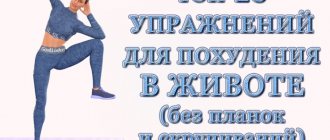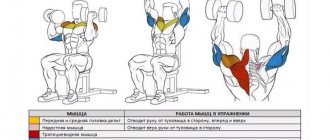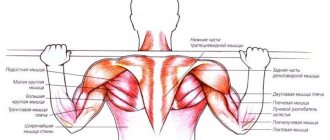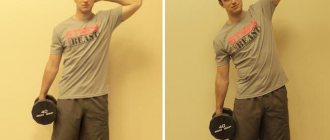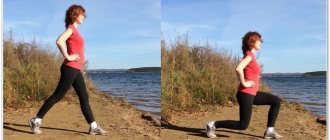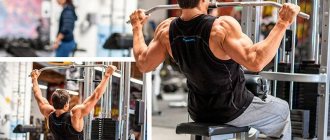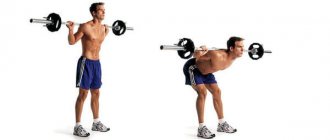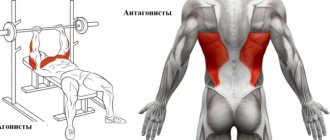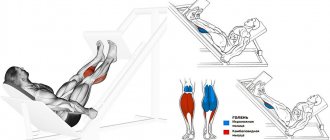Side bends with a barbell[edit | edit code]
Inventory
:barbell.
Core muscles
: oblique abdominal muscles.
Additional muscles
: anterior abdominal muscles, back muscles.
Level of training
: initial.
CHECK THE MOUNTINGS! Secure fastening of the rod locks is very important. Check this before starting the exercise.
Step 1
. Feet shoulder width apart. The bar rests on the shoulders and is held by the hands.
Step 2
. Bend to the right side.
Step 3
. Return to the starting position. While bending, keep your torso straight, avoiding bending forward and backward. Return strictly to the starting position without deviating from the vertical. Bend in the opposite direction.
Execution technique
- Take the starting position:
for standing rows on the right side: tilt your body forward, placing your left hand on the support, bring your left leg forward, and take your right leg back, lower your right hand from the dumbbells to the floor;for rows with emphasis on the knee: approach the bench from the end, place your left knee and left hand on it, move your right leg back and to the side, it should be straight, lower your right hand from the dumbbells to the floor.
- Raise the dumbbell to your waist as high as possible, bending your arm at the shoulder and elbow joints. At the top point, maintain a 90-degree angle between your shoulder and forearm, tense the right side of your back, contracting your shoulder blade as much as possible.
- Lower your arm, returning to the starting position.
- Do the required number of repetitions on the right side, then on the left.
- During the exercise, keep your back straight, do not round it, and maintain a slight arch in your lower back. Control your posture - your shoulders should be straightened.
To raise the dumbbell to the desired height (above shoulder level), apply a strong force at the beginning of its upward movement.
The back can be fixed almost motionless or actively worked with it. In the first version, the shoulder joint rises and falls slightly during the exercise.
In the second, when lowering and raising the dumbbell, you must also actively lower and raise your shoulder, stretching and contracting the latissimus muscle as much as possible.
Which one to choose is a matter of personal preference: if you work with the shoulder, the amplitude of movements is maximum, but at the lowest point the muscles receive a short rest; if the shoulder joint is practically motionless, the amplitude is smaller, but the target muscles work continuously throughout the entire approach.
Lateral tilts in a vertical block[edit | edit code]
Inventory
:block simulator.
Core muscles
: oblique abdominal muscles.
Additional muscles
: rectus abdominis, biceps.
Level of training
: advanced.
Step 1
. Stand with your side to the pulley device and grab the rope attached to the lower pulley with your left hand. You can also use any comfortable handle.
Step 2
. Lean to the right and pull the rope down.
Step 3
. Having completed the prescribed number of bends in one direction, repeat the movement with the other hand.
Body tilts[edit | edit code]
Inventory
: dumbbells.
Core muscles
: oblique muscles and muscles of the lower abdomen.
Additional muscles
: thigh muscles, lumbar.
Level of training
: initial.
Step 1
. Feet shoulder width apart. Hands with dumbbells are bent at the elbows and raised above the head.
Step 2
. Tilt your body to the left. Don't give up. Return to the starting position.
Step 3
. Repeat the bend on the other side.
Do not lean forward or backward while moving, only to the sides. Don't bend your knees.
Exercises with dumbbells for the back and arms
Bent-over dumbbell raises
Place your feet shoulder-width apart with your knees slightly bent. Bend your body forward almost parallel to the floor, and take a dumbbell in each hand. Extend your arms out to your sides as far back as possible. Elbows should be higher than shoulder level. Return to the starting position.
Dumbbell Vertical Row
Place your feet shoulder-width apart, hold dumbbells in front of you with your arms straight. Palms facing the body. Pull the dumbbells toward your upper chest. In this case, the elbows should be higher than shoulder level.
Bent delt swings
Delta, delta, delta! And there is an exercise for you. Lie with your chest on an incline bench. Hold dumbbells in front of you. Palms point inward. Extend your arms out to the sides and back. In this case, you can bend your arms slightly at the elbows.
Swing one arm to the side
Sit with your left side on an incline bench. With your right hand, lift the dumbbell over your head and above your shoulders through your right side. Return to the starting position. Complete the required number of repetitions and sit on the other side.
Alternate dumbbell press up
Hold dumbbells on your shoulders. Raise your right arm up, fully straightening. Lower it. Do the same with your left hand. This counts as one repetition.
Spider curls for biceps
An exercise worthy of Peter Parker will help you add some volume to your biceps. Lie with your chest on an incline bench. Hold dumbbells in front of you. Palms facing forward. Bend your elbows and lift the dumbbells toward your chin. Don't swing as you perform (Isolation, baby!) Return to the starting position. Want variety? Perform this exercise alternating your left and right hands.
Bend the arms while sitting at an angle
A little more effort. Sit on an incline bench (45 degree angle), holding a dumbbell in each hand (palms facing your hips). Simultaneously bend both arms at the elbows and pull the weight towards your chest. Try to move only your arms, do not help yourself with your body (sounds much easier than it actually is!)
French bench press with dumbbells
The name of the exercise speaks for itself. Lie with your back on a bench, feet on the floor, lower back tightly pressed. Extend your arms with dumbbells in front of you (palms facing each other). Then, bending only your elbows, lower the weight towards your ears, stopping when you reach a 90-degree angle. Return to starting position
Bent-over dumbbell row
Actor James Dean apparently performs this exercise in his sleep. The starting position is the same as for push-ups: feet shoulder-width apart, arms straight in front of the chest, a dumbbell in each hand. Pull the right dumbbell toward your obliques, keeping your arm as close to your torso as possible. Lower your arm back to the starting position. Repeat with your left hand. Alternately perform the required number of repetitions.
Side bends with dumbbells
It's time for a good stretch. Hold a dumbbell overhead with both hands. Without turning your body, lean to the right until you feel a stretch in the muscles on the left. Return to the starting position and repeat on the other side.
Russian twist
Sit on an exercise mat, holding a dumbbell in each hand. Holding the dumbbells in front of you, move them to your right side, moving only your arms (don't even think about turning your body!) Keeping your back straight, move the weight to your left side. Perform the required number of repetitions.
"Mill"
Are you ready to clear the clouds? With your feet slightly wider than shoulder-width apart, straighten your right arm with the dumbbells overhead. Turn your legs slightly to the left. Now, continuing to keep your right hand overhead, tilt your body forward until the fingers of your left hand touch the floor. Focus on the weight to maintain balance. Return to the starting position. Don't forget to change hands.
Lumberjack with dumbbells
For lumberjacks, this exercise will seem painfully familiar. Place your feet shoulder-width apart and hold the dumbbell in front of you. Squat down, turning to the right and pointing the dumbbell towards your right leg. Return to the starting position with the dumbbell in front of you again. Repeat the same on the left side.
Based on materials:
https://greatist.com/fitness/30-dumbbell-exercises-missing-your-routine
Side bends with dumbbells[edit | edit code]
Inventory
: dumbbells.
Core muscles
: oblique and lateral abdominal muscles.
Additional muscles
: anterior abdominal muscles, back.
Stabilizing muscles
- Abdominal muscle group.
- Torso: Quadratus lumborum, erector spinae, adductor group, gluteus medius and minimus.
- Shoulder joints: Rotator muscles.
- Shoulders: Serratus anterior, rhomboids, and lower trapezius muscles.
Level of training
: initial.
When lateral bending with dumbbells, mainly the oblique and lateral abdominal muscles are involved.
Step 1
. Feet shoulder width apart. Take a dumbbell in your hand. Keep your arm straight at your hip.
Step 2
. Bend the dumbbells to the side.
Step 3
. Return to the starting position.
While bending, keep your torso straight, avoiding bending forward and backward.
Return strictly to the starting position without deviating from the vertical.
Tips on proper exercise technique
:
- Do not use inertial force. Make slow, controlled movements.
- Don't slouch or round your shoulders. Keep your chest out; shoulder blades flattened.
- The hips should remain motionless, maintaining their original position relative to the feet.
- Inhale as you move down.
- Focus on isolated work of the abdominal and lower back muscles on the opposite side of the dumbbell.
- These muscles are equally active in up and down movements. Slowly lower your upper body to the starting position and tighten your ribs.
- Muscles working when lateral bending with dumbbells: 1 - external oblique abdominal muscle; 2 - rectus abdominis muscle
- Side bends with dumbbells
Execution technique
The task is determined by bending the torso to the side, with dumbbells in the hands, like this:
- Stand straight, keep your feet shoulder-width apart. Take the sports equipment with your right hand with a straight grip, fix the left one at your waist. Keep your head straight, tensing the muscles of your upper and lower abs.
- Take a short breath, tilt your torso to the right, while keeping your back straight. You should bend down as low as possible, holding it for a few seconds. Return to the starting position - negative phase, exhale.
- Take a dumbbell with your left hand with a straight grip, place your right hand on your waist. After a short inhalation, bend towards the dumbbell. After a short hold, return to a vertical position and exhale.
Technically correct training will reduce waist size and subcutaneous fat. Some rules will help you execute it correctly:
- the position of the legs strictly corresponds to the width of the shoulders, the free hand is fixed on the belt;
- the abdominal muscles are tense, the shoulders are straightened, the hips are stationary, there is no deflection of the lumbar girdle;
- bending is carried out strictly straight to the possible position, the sports equipment slides along the line of the leg;
- the tilt stretches the opposite side of the torso, then the latter rises slightly, including the external oblique muscles in the work;
- Beginners can make the exercise easier by slightly bending their knees when performing the bend.
Failure to follow the rules not only results in lack of exposure, but also injury. For example, bending over with a relaxed press does not load the oblique muscles, but the lumbar spinal column. Instead of losing weight, a beginner faces the risk of developing a vertebral hernia. The fixed position of the torso prevents the possibility of abrasion of the intervertebral plates and pinched nerves. Weighting materials that are inadequate for the athlete’s weight contribute to an increase in the external oblique muscle and lead to an increase in waist width.
It is recommended to perform up to 15 repetitions in each direction with 5-10 kg dumbbells, 2 sets. Women reduce the weight of the sports equipment by half with the same number of repetitions and approaches. Approaches alternate with short rests and are performed at a smooth pace. The training is additional for grinding the terrain.
Notes and features[edit | edit code]
Dumbbell bending allows you to improve your posture, reduce your sides and fat deposits. When performing side bends with dumbbells, you need to bend strictly to the side; for this you can neglect the depth of the bend. The pelvis must be motionless; in order to bend lower, you need to place your feet shoulder-width apart. You can complement the side bends by moving your arm above your head, which will significantly enhance the work of the oblique abdominal muscles.
To increase the amplitude of the exercise, when lifting from dumbbells, you need to lean slightly towards the contracting muscle, which will increase the load on it. More weight increases the effectiveness of such exercises.
It is recommended to perform this load in three sets of 15-20 repetitions no more than twice a week. It should also be remembered that an increase in the volume of the oblique abdominal muscles, as a result of training, can lead to an increase in the waist, which is often an undesirable consequence for girls. Exercise can improve the condition of muscles, strengthen them, and cause intense calorie burning.
Do not use too much weight, as this can cause spinal injuries.
Bends forward from a standing and sitting position
It would seem, What could be simpler than tilting? But as the Russian proverb says, “Don’t say gop until you jump over.”
In fact, bending over is a fairly difficult exercise. There are more than 40 types of this exercise in the world, but in this article we will talk about the most effective of them. We will talk about bending forward with closed legs.
Bend forward from a sitting position at school, legs together (cm) | ||||||
| Boys | Class | Girls | ||||
| 5 | 4 | 3 | 5 | 4 | 3 | |
| +6 | +3 | +1 | 1 class | +7 | +5 | +3 |
| +7 | +4 | +2 | 2nd grade | +8 | +6 | +4 |
| +8 | +5 | +3 | 3rd grade | +9 | +7 | +4 |
| +9 | +6 | +4 | 4th grade | +10 | +8 | +5 |
| +10 | +8 | +6 | 5th grade | +12 | +8 | +5 |
GTO Bend forward from a standing position with straight legs on a gymnastic bench
The GTO program provides for passing standards in all age categories, and this is an indicator of the importance of this exercise in a person’s healthy lifestyle
| Boys | GTO Bend forward from a standing position with straight legs on a gymnastic bench (from the level of the bench - cm) | Girls | ||||
| +1 | +3 | +7 | 1st stage (6-8 years) | +3 | +5 | +9 |
| +2 | +4 | +8 | Level 2 (9-10 years) | +3 | +5 | +11 |
| +3 | +5 | +9 | Level 3 (11-12 years old) | +4 | +6 | +13 |
| +4 | +6 | +11 | Level 4 (13-15 years old) | +5 | +8 | +15 |
| +6 | +8 | +13 | Level 5 (16-17 years old) | +7 | +9 | +16 |
| Men | Women | |||||
| +6 | +8 | +13 | Level 6 (18-24 years old) | +8 | +11 | +16 |
| +5 | +7 | +12 | Level 6 (25-29 years old) | +7 | +9 | +14 |
| +3 | +5 | +11 | 7th stage (30-34 years old) | +5 | +7 | +13 |
| +2 | +4 | +10 | 7th stage (35-39 years old) | +4 | +6 | +12 |
| +1 | +3 | +9 | 8th stage (40-44 years old) | +2 | +4 | +11 |
| 0 | +2 | +8 | 8th stage (45-49 years old) | +2 | +4 | +10 |
| -1 | +1 | +7 | 9th stage (50-54 years old) | +1 | +3 | +9 |
| -2 | 0 | +5 | 9th stage (55-59 years old) | +1 | +3 | +8 |
| -6 | -4 | -1 | 10th stage (60-64 years old) | 0 | +2 | +6 |
| -8 | -6 | -4 | 10th stage (65-69 years old) | -4 | -1 | +2 |
| -10 | -8 | -6 | 11th stage (70+ years) | -6 | -4 | 0 |
Video:
Why do we need forward bends: firstly, they tone our muscles, and secondly, they develop flexibility. And this is only a small part of their potential. Although the technique itself is quite simple, it requires compliance with some nuances. Since bending forward with closed legs is a warm-up exercise, its benefits for the body are invaluable, and due to the fact that it does not require special training or equipment, it can be freely included in a set of home exercises. Forward bending affects our body in the following ways:
- Makes our spine more flexible and joints mobile, preventing arthritis, osteochondrosis and osteoporosis.
- Improves blood circulation, thereby reducing the risk of strokes and heart attacks.
- The tendons become elastic due to periodic stretching.
- The abdominal muscles, gluteus maximus, and quadratus lumborum muscles are trained.
To perform this exercise correctly, it is important to adhere to the following technique. Firstly, you need to stand up straight with your back straight, feet together, the arch of the lower back should be sufficiently natural without any curvature. Secondly, take a breath and, tensing your abdominal muscles, smoothly (without strain) lower your body down until your toes touch the floor or the tips of your legs. If you lack flexibility, you can bend your knees slightly. This will make the exercise easier. After all the actions done, you need to stay in this position for a couple of seconds, and while exhaling, return to the starting position.
When performing a torso raise, it is important to remember that it is done by the gluteal muscles. If you perform this movement using your back extensors, you can get seriously injured. For beginners in this exercise, only two or three approaches 10-15 times a day are required to achieve good results after just a month of training. As for breathing techniques, it should be set according to the anatomical characteristics of each person.
What are the contraindications?
Despite the obvious benefits, bending forward has a number of contraindications such as:
- spinal injuries;
- acute pulmonary failure;
- cholesterol plaques in blood vessels;
- displacement of intervertebral discs;
- advanced forms of arthritis;
- allergy;
- pregnancy and lactation;
- oncological diseases;
- atrial fibrillation;
- spinal hernia;
- hypertensive and hypotensive crises.
because, like most similar exercises, forward bends came to us from yoga. Therefore, the approach to this exercise must be true to its origins. Under no circumstances should you rush. The movement should be smooth. Jerks are not allowed. Breathing should be smooth and constant. Keep your feet straight and turn your heels inward. Do not help yourself too much with your hands as this can lead to back injuries.
Once athletes have achieved sufficient flexibility, they can use weights. At home, these can be bottles filled with water. While in the gym, take dumbbells and try to bend over with them. Select the weight of the weights according to your capabilities.
As a result, if all recommendations and safety measures are strictly followed, after a week of training the results will not be long in coming.
| +1 | +3 | +7 | 1st stage (6-8 years) | +3 | +5 | +9 |
| +2 | +4 | +8 | Level 2 (9-10 years) | +3 | +5 | +11 |
| +3 | +5 | +9 | Level 3 (11-12 years old) | +4 | +6 | +13 |
| +4 | +6 | +11 | Level 4 (13-15 years old) | +5 | +8 | +15 |
| +6 | +8 | +13 | Level 5 (16-17 years old) | +7 | +9 | +16 |
| Men | Women | |||||
| +6 | +8 | +13 | Level 6 (18-24 years old) | +8 | +11 | +16 |
| +5 | +7 | +12 | Level 6 (25-29 years old) | +7 | +9 | +14 |
| +3 | +5 | +11 | 7th stage (30-34 years old) | +5 | +7 | +13 |
| +2 | +4 | +10 | 7th stage (35-39 years old) | +4 | +6 | +12 |
| +1 | +3 | +9 | 8th stage (40-44 years old) | +2 | +4 | +11 |
| 0 | +2 | +8 | 8th stage (45-49 years old) | +2 | +4 | +10 |
| -1 | +1 | +7 | 9th stage (50-54 years old) | +1 | +3 | +9 |
| -2 | 0 | +5 | 9th stage (55-59 years old) | +1 | +3 | +8 |
| -6 | -4 | -1 | 10th stage (60-64 years old) | 0 | +2 | +6 |
| -8 | -6 | -4 | 10th stage (65-69 years old) | -4 | -1 | +2 |
| -10 | -8 | -6 | 11th stage (70+ years) | -6 | -4 | 0 |

